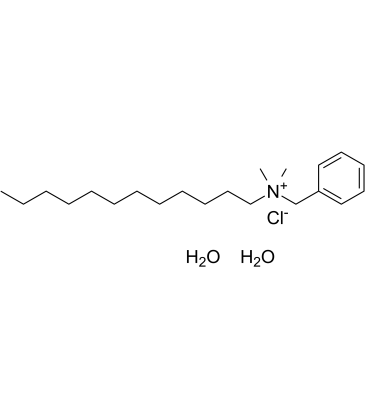Benzyldodecyldimethylammonium chloride dihydrate |
| Catalog No.GC60639 |
Benzyldodecyldimethylammonium chloride dihydrate is a quaternary ammonium compound (QAC) and can be used as a biocide to target antibiotic-resistant bacteria, such as methicillin-resistant?Staphylococcus aureus?(MRSA), multidrug-resistant (MDR)?P.
Products are for research use only. Not for human use. We do not sell to patients.

Cas No.: 147228-80-6
Sample solution is provided at 25 µL, 10mM.
Benzyldodecyldimethylammonium chloride dihydrate is a quaternary ammonium compound (QAC) and can be used as a biocide to target antibiotic-resistant bacteria, such as methicillin-resistant Staphylococcus aureus (MRSA), multidrug-resistant (MDR) P. aeruginosa et. al. Benzyldodecyldimethylammonium chloride dihydrate, an antimicrobial agent, bacteriostatic or bactericidal properties depending on the concentration[1][2].
Benzyldodecyldimethylammonium chloride dihydrate (1-10 μM; 2 hours) results in a dose-dependent changes in the percent population of dead rat thymocyte cells[1].Benzyldodecyldimethylammonium chloride dihydrate (0-40 mg/L; 0-24 hours) inhibits P. fluorescens with a MIC of 20 mg/L. At 5 mg/L, cells have the same growth behaviour as the control. At concentrations of 10 and 15 mg/L the growth profile is different from the control, and the cells start to grow only after 8 h of adaptation. At concentrations of ≥20 mg/L, BDMDAC inhibits cell growth[2].Benzyldodecyldimethylammonium chloride dihydrate interacts strongly with cell surfaces in a concentration-dependent manner, and binds by ionic and hydrophobic interactions to microbial membrane surfaces, as manifested by phenomena such as membrane disruption and loss of membrane integrity with consequent leakage of essential intracellular constituents, which promote significant and irreversible changes in the cell structure[2]. Cell Viability Assay[1] Cell Line: Rat thymocyte cells
[1]. Sadegh Ghanbar, et al. New Generation of N-Chloramine/QAC Composite Biocides: Efficient Antimicrobial Agents To Target Antibiotic-Resistant Bacteria in the Presence of Organic Load. ACS Omega. 2018 Aug 22;3(8):9699-9709. [2]. Tsuyoshi Mitani, et al. Zinc-related actions of sublethal levels of benzalkonium chloride: Potentiation of benzalkonium cytotoxicity by zinc. Chem Biol Interact. 2017 Apr 25;268:31-36.
Average Rating: 5 (Based on Reviews and 4 reference(s) in Google Scholar.)
GLPBIO products are for RESEARCH USE ONLY. Please make sure your review or question is research based.
Required fields are marked with *




















